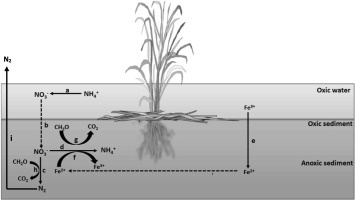Science of the Total Environment ( IF 8.2 ) Pub Date : 2019-02-15 , DOI: 10.1016/j.scitotenv.2019.02.225 Md. Moklesur Rahman , Keryn L. Roberts , Michael R. Grace , Adam J. Kessler , Perran L.M. Cook

|
Denitrification (DNF) and dissimilatory nitrate reduction to ammonium (DNRA) are two competing nitrate reduction pathways that remove or recycle nitrogen, respectively. However, factors controlling the partitioning between these two pathways are manifold and our understanding of these factors is critical for the management of N loads in constructed wetlands. An important factor that controls DNRA in an aquatic ecosystem is the electron donor, commonly organic carbon (OC) or alternatively ferrous iron and sulfide. In this study, we investigated the role of natural organic carbon (NOC) and acetate at different OC/NO3− ratios and ferrous iron on the partitioning between DNF and DNRA using the 15N-tracer method in slurries from four constructed stormwater urban wetlands in Melbourne, Australia. The carbon and nitrate experiments revealed that DNF dominated at all OC/NO3− ratios. The higher DNF and DNRA rates observed after the addition of NOC indicates that nitrate reduction was enhanced more by NOC than acetate. Moreover, addition of NOC in slurries stimulated DNRA more than DNF. Interestingly, slurries amended with Fe2+ showed that Fe2+ had significant control on the balance between DNF and DNRA. From two out of four wetlands, a significant increase in DNRA rates (p < .05) at the cost of DNF in the presence of available Fe2+ suggests DNRA is coupled to Fe2+ oxidation. Rates of DNRA increased 1.5–3.5 times in the Fe2+ treatment compared to the control. Overall, our study provides direct evidence that DNRA is linked to Fe2+ oxidation in some wetland sediments and highlights the role of Fe2+ in controlling the partitioning between removal (DNF) and recycling (DNRA) of bioavailable N in stormwater urban constructed wetlands. In our study we also measured anammox and found that it was always <0.05% of total nitrate reduction in these sediments.
中文翻译:

人工雨水城市湿地中有机碳,硝酸盐和二价铁在反硝化作用与DNRA分配之间的作用
反硝化(DNF)和硝酸盐异化还原为铵(DNRA)是分别去除或循环利用氮的两种竞争性硝酸盐还原途径。但是,控制这两个路径之间分配的因素是多种多样的,我们对这些因素的理解对于管理人工湿地中的氮负荷至关重要。控制水生生态系统中DNRA的重要因素是电子给体,通常是有机碳(OC)或亚铁和硫化亚铁。在这项研究中,我们研究了在不同的OC天然有机碳(NOC)和乙酸的作用/ NO 3 -上DNF和DNRA使用之间的分隔比和二价铁15N示踪法从澳大利亚墨尔本的四个人工雨水城市湿地中提取的泥浆。碳和硝酸实验表明DNF在所有OC / NO为主3 -比率。加入NOC后观察到较高的DNF和DNRA速率,表明NOC比乙酸盐对硝酸盐还原的促进作用更大。此外,在浆液中添加NOC比DNF对DNRA的刺激更大。有趣的是,用Fe 2+改性的浆料表明Fe 2+对DNF和DNRA之间的平衡具有显着的控制作用。在四分之二的湿地中,在存在可用的Fe 2+的情况下,以DNF为代价,DNRA速率显着增加(p <.05),这表明DNRA与Fe 2+偶联氧化。与对照组相比,Fe 2+处理中DNRA的速率增加了1.5-3.5倍。总体而言,我们的研究提供了直接证据,表明DNRA与某些湿地沉积物中的Fe 2+氧化有关,并强调了Fe 2+在控制雨水城市人工湿地中生物有效性氮的去除(DNF)和循环利用(DNRA)之间的分配中的作用。。在我们的研究中,我们还测量了厌氧氨水,发现这些沉积物中的总硝酸盐含量总是<0.05%。


















































 京公网安备 11010802027423号
京公网安备 11010802027423号